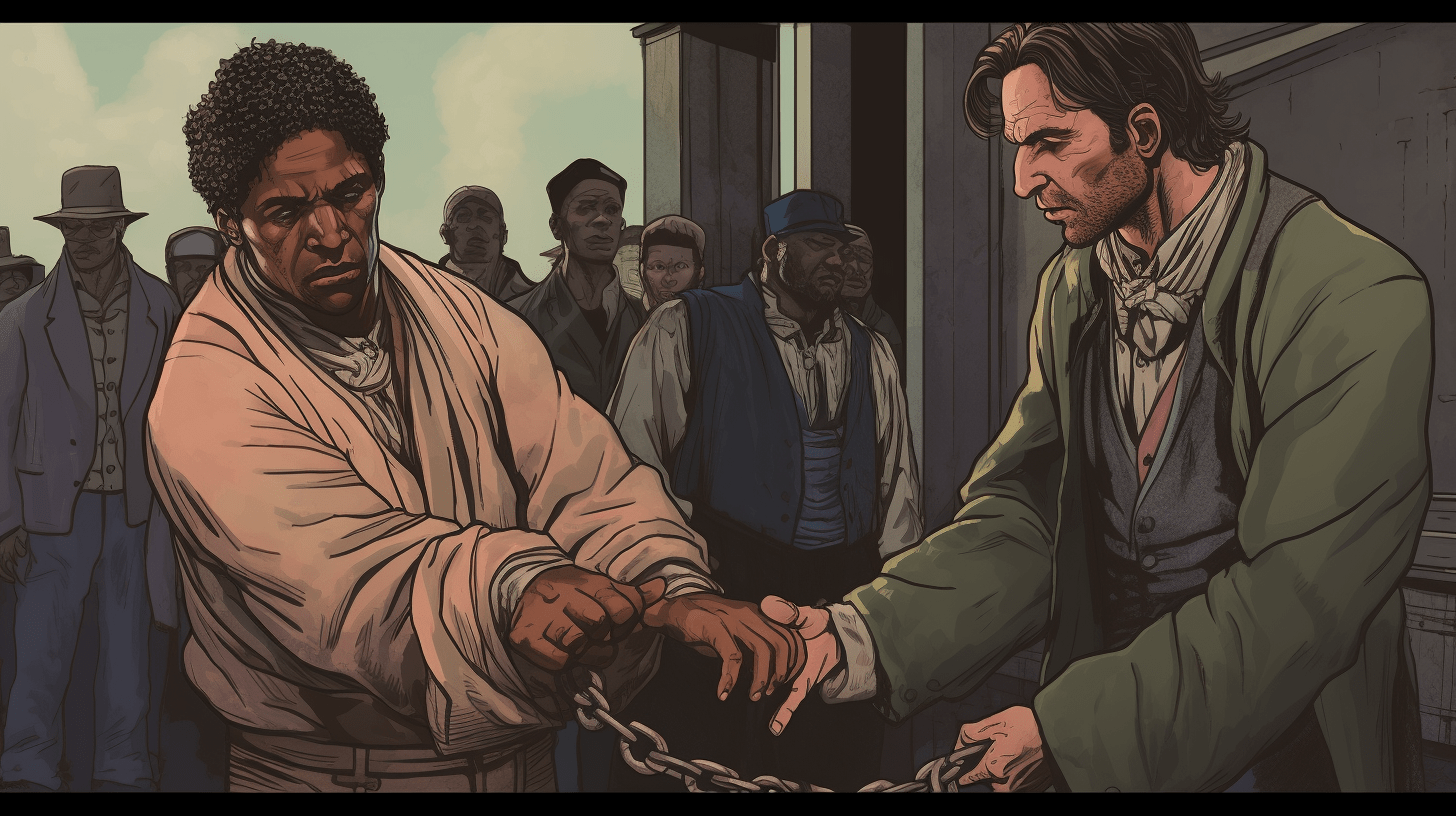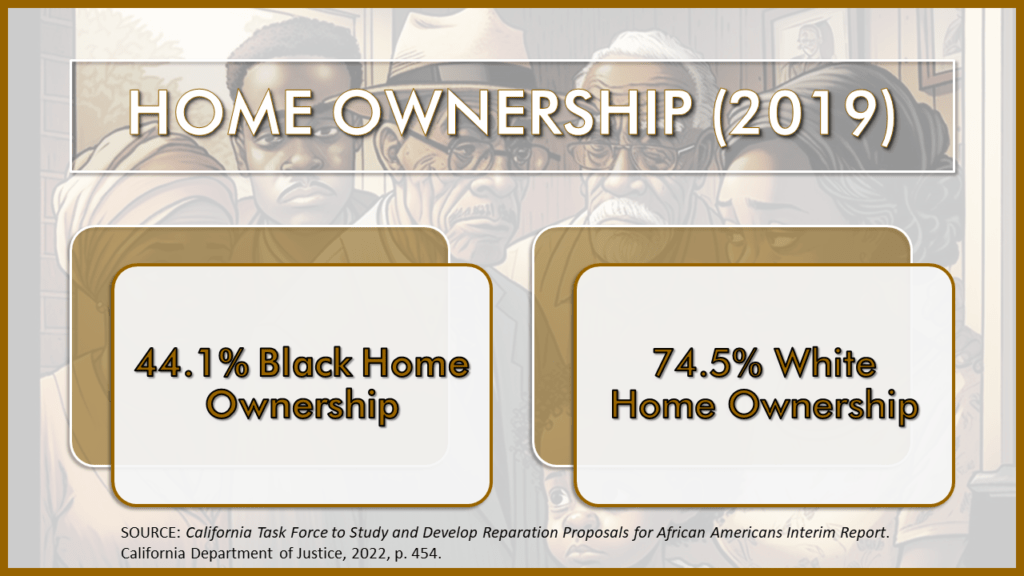*Ad Free Videos for as little as $1/Month Subscription!!*
Debunking the ‘Free State’ Fallacy: Why Reparations in California Matter
By Darius Spearman (africanelements)
About the author: Darius Spearman is a professor of Black Studies at San Diego College, where he has been pursuing his love of teaching since 2007. He is the author of several books, including Between The Color Lines: A History of African Americans on the California Frontier Through 1890. You can visit Darius online at africanelements.org.
Background on the concept of reparations
Reparations are a form of compensation provided to a group of people who have experienced historical wrongs and injustices. This concept has been a topic of discussion for decades, particularly in the context of slavery and the systemic racism that continues to affect African Americans in the United States. The debate surrounding reparations is complex and multifaceted, with many people holding differing opinions on the matter.
California is often seen as a progressive state that has historically been at the forefront of social change. Many people are under the impression that California was not a slave state, and thus question why reparations are being considered in this context. However, this view is not entirely accurate, as California did indeed have a significant number of slaves and passed legislation that was friendly to slave owners, such as the 1852 Fugitive Slave Law.
While slavery is a significant factor in the discussion of reparations, it is crucial to understand that the concept of reparations extends beyond this singular issue. Reparations address not only the historical wrongs related to slavery but also the systemic racism and discriminatory practices that have persisted and continue to harm African Americans in various aspects of life.
Slavery in California

California was admitted to the Union as a free state in 1850, but that did not mean that slavery was entirely absent. Slavery was practiced in California, primarily by Southern slave owners who brought enslaved individuals with them as they migrated westward. This presence of slavery in the state demonstrates that California was not entirely free from the legacy of slavery, contrary to popular belief.
The 1852 Fugitive Slave Law
In 1852, California passed its own Fugitive Slave Law, which allowed for the capture and return of escaped slaves to their owners. This law was a clear indication of the state’s support for slave owners and further entrenches California’s connection to the history of slavery in the United States.

California’s 1852 Fugitive Slave Law had significant consequences that reinforced the institution of slavery and perpetuated the mistreatment of enslaved individuals (Ettinger). This law allowed for the capture and return of escaped slaves to their owners, aligning California with the pro-slavery sentiments of the time (Ettinger).
California’s 1852 Fugitive Slave Law had significant consequences that reinforced the institution of slavery and perpetuated the mistreatment of enslaved individuals (Ettinger). In line with the National Fugitive Slave Act of 1850 that accompanied California’s admission into the union as a “free” state, the law allowed for the capture and return of escaped slaves to their owners, aligning California with the pro-slavery sentiments of the time (Ettinger). However, the California law went a step further. In addition to requiring local authorities and citizens to actively participate in capturing and returning escaped (or fugitive) slaves, California’s harsher law didn’t even require enslaved blacks in California to be fugitives. The law applied even when enslavers brought their human property into California. As a consequence, there were approximately 4,086 slaves present in California, according to the 1860 U.S. Census. All told, enslaved Blacks in California paid an estimated $750,000 to free themselves and their families during the period leading up to the Civil War.

The Fugitive Slave Law in California also contributed to the overall culture of racism and discrimination against African Americans. It sent a clear message that even in a state labeled as “free,” the rights and well-being of enslaved individuals were disregarded in favor of maintaining white supremacy and the institution of slavery. In fact, white supremacy was codified in California’s legal framework such that both free and enslaved blacks were denied the right to vote and the right to testify and serve on juries, effectively turning California into an unsafe environment for both free and enslaved blacks. Additionally, while white citizens could settle unclaimed land under the homestead act of 1862, California denied Blacks homesteading rights.
Racial Discrimination:Slavery’s Ugly Cousin
Beyond the issue of slavery, California has a long history of racial discrimination against African Americans. From housing discrimination and redlining to employment and wage disparities, African Americans in California have faced a multitude of challenges that have contributed to the racial wealth gap that persists to this day.
The racial wealth gap

The wealth gap between Black and white Americans is a direct result of centuries of racial inequality and discrimination, including historical and contemporary practices in housing, education, and employment (“California Task Force to Study and Develop Reparation Proposals for African Americans INTERIM REPORT,” 2022, p. 451). In 2019, the median Black household had only $24,100 in wealth compared to $188,200 for the median white household (ibid., p. 452). This stark disparity has far-reaching consequences for the economic stability and opportunities available to African Americans in California and throughout the United States.
Homeownership and redlining

Homeownership rates for Black families have remained stubbornly low at 44.1 percent in 2019, compared to 74.5 percent for white families (“California Task Force to Study and Develop Reparation Proposals for African Americans INTERIM REPORT,” 2022, p. 454). This gap in homeownership is a significant contributor to the racial wealth gap, as owning a home is a primary means of accumulating wealth. Redlining, racially restrictive covenants, and other policies have perpetuated residential segregation and limited opportunities for wealth building for African Americans (ibid., p. 456).
Employment and wages
African Americans are more likely to experience underemployment, unemployment, and lower wages than white Americans, further contributing to the racial wealth gap (“California Task Force to Study and Develop Reparation Proposals for African Americans INTERIM REPORT,” 2022, p. 462). Discriminatory hiring practices, occupational segregation, and a lack of access to quality education and job training opportunities have created barriers for African Americans in the workforce.
Intergenerational wealth transfers

A significant portion of an adult’s wealth position is directly linked to intergenerational transfers, such as inheritances or gift money, which are less common for African Americans (“California Task Force to Study and Develop Reparation Proposals for African Americans INTERIM REPORT,” 2022, p. 472). This lack of intergenerational wealth transfers exacerbates the racial wealth gap, as African American families are less likely to receive financial support from previous generations, further limiting their ability to accumulate wealth and pass it on to future generations.
Why Reparations in California is the Answer
Addressing Historical Wrongs
Reparations are a means to address the historical wrongs committed against African Americans, including the legacy of slavery and ongoing systemic racism. By providing compensation to those who have been harmed, reparations aim to acknowledge and redress these injustices and contribute to the healing process for African American communities.
“The persistent racial wealth gap threatens the economic security of African Americans and perpetuates economic inequality .”
(“CALIFORNIA TASK FORCE TO STUDY AND DEVELOP REPARATION PROPOSALS FOR AFRICAN AMERICANS INTERIM REPORT,” 2022, P. 490)
Reparations can play a crucial role in addressing these disparities by providing financial support to African American families and communities, helping to close the wealth gap and promote greater economic equality.
Reparations as a means of healing
Implementing reparations can have far-reaching societal benefits, as they work to address systemic issues that have persisted for centuries. By acknowledging the historical wrongs and injustices committed against African Americans, reparations can help foster a greater understanding of the systemic racism that continues to permeate society. This increased awareness can lead to the development of more equitable policies and practices that benefit all Americans.
Promoting unity and understanding
Reparations can play a role in promoting unity and understanding between different racial and ethnic groups within the United States. By acknowledging the harm caused by slavery and systemic racism, reparations can encourage a national dialogue on race, fostering empathy and promoting a greater sense of shared history and identity among all Americans.
Conclusion
Reparations are a complex and multifaceted issue that extends beyond the context of slavery. While California is often perceived as a state with no connection to slavery, this is not entirely accurate. The state had a significant number of slaves, passed legislation supporting slave owners, and has a long history of racial discrimination in various aspects of life. The persistent racial wealth gap, fueled by disparities in homeownership, employment, and intergenerational wealth transfers, highlights the need for reparations as a means to address these disparities and promote economic equality.
Reparations can serve as a crucial step in addressing historical wrongs, fostering greater understanding and unity among Americans, and promoting a more equitable society. By considering reparations in California and beyond, policymakers can work towards creating a more inclusive and just future for all Americans.
FAQs
What is the racial wealth gap?
The racial wealth gap refers to the significant disparities in wealth between Black and white Americans, which is primarily a result of historical and ongoing racial discrimination and systemic racism.
What role did California play in the history of slavery in the United States?
Though California was admitted to the Union as a free state in 1850, slavery was practiced in the state. California also passed the 1852 Fugitive Slave Law, which supported slave owners by allowing the capture and return of escaped slaves.
How do intergenerational wealth transfers contribute to the racial wealth gap?
Intergenerational wealth transfers, such as inheritances and gift money, are less common for African Americans. This lack of financial support from previous generations limits African American families’ ability to accumulate wealth and pass it on to future generations, exacerbating the racial wealth gap.
How can reparations help to address the racial wealth gap?
Reparations can provide financial support to African American families and communities, helping to close the wealth gap and promote greater economic equality. Additionally, reparations can contribute to a more equitable tax system and address other systemic issues that perpetuate the racial wealth gap.
What are some societal benefits of implementing reparations?
Reparations can help foster a greater understanding of systemic racism, encourage national dialogue on race, and promote unity and understanding among different racial and ethnic groups in the United States. They can also contribute to the development of more equitable policies and practices that benefit all Americans.
SOURCES:
Ettinger, Amos. “California’s Fugitive Slave Law.” KCET, 10 Dec. 2015, www.kcet.org/shows/lost-la/californias-fugitive-slave-law.
